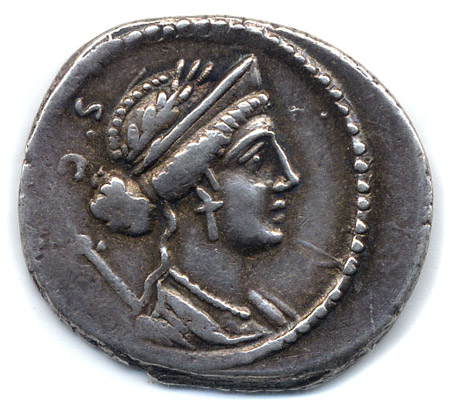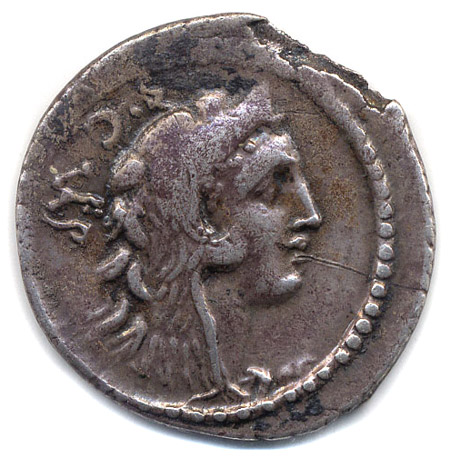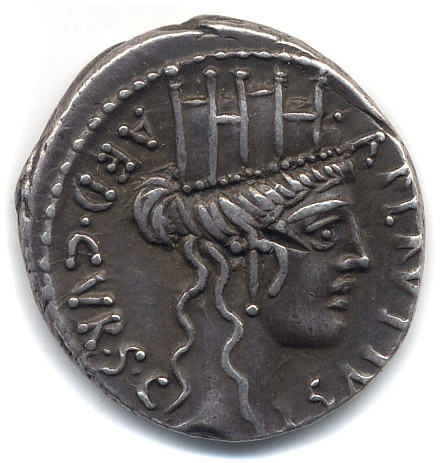Military Triumph: The Coins of Pompey
While the coinage of Pompey's supporters during the civil war did not reflect contemporary events, coinage struck by his supporters before the civil war reflects his activities and the concerns of his opponents. These earlier coins were largely released in the mid 50s BC (e.g. RRC 426/1-4, 431/1, 436/1)
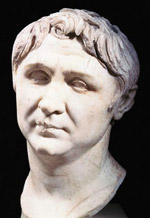
It should be noted that the first numismatic reference to Pompey's career only occurred well after Pompey's commands against the pirates (67 BC) and Mithridates (66 BC). In 56 BC Pompey, Crassus and Caesar met at Luca to renegotiate the triumvirate. The same year Faustus Sulla released a coin (RRC 426/3) with Venus on the obverse and three trophies on the reverse. Pompey's claims to Venus are discussed in the section on that goddess. Crawford (1974:450) suggested that the three trophies reproduced Pompey's signet ring as described by Dio, who records that Pompey's ring had "three trophies carved on it, as had that of Sulla." (Dio 42.18.3) The lituus and jug on the reverse allude to Pompey's augurate. Another coin (RRC 426/4a) struck by Faustus Sulla in the same year displays Hercules on the obverse and on the reverse a globe surrounded by three small wreaths and one large wreath. The three small wreaths recall Pompey's three triumphs (Plutarch, Pomp 45.5 – triumphs over the continents of Libya, Europe and Asia) and the large wreath perhaps represents the corona aurea (golden crown) granted to Pompey in 63 BC (Dio 37.21.4). The globe on the coin may recall the trophy of the inhabited world that Dio states was included in Pompey's triumph (Dio 37.21.2), while the aplustre (ship ornament) and corn ear might be linked with Pompey's position as Cura Annonae in 57 B.C.
Pompey also had a special connection to Hercules, probably inherited from his father-in-law Sulla; Pompey had dedicated a temple or shrine to the god in Rome and as a result it carried his name: aedes Herculis Pompeiani (Pliny NH 7.95). The theme of the four wreaths is repeated in 52 BC on RRC 436/1, which displays Victory carrying a palm branch with four wreaths on its reverse. On these coins with specific reference to Pompey's achievements Faustus Sulla minimises his name to a monogram (RRC 426/3, 4a), while on other coins referring to his father Lucius Cornelius Sulla he displays his name in full (RRC 426/1, 2). On one version of RRC 426 he does not put his name on the coin at all (RRC 426/4b). The effect was to emphasise the reference to Pompey on the coins - Faustus Sulla did not want to detract from the allusions with his own name.
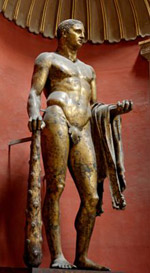
The next year Pompey became consul in accordance with the agreement at Luca, and another coin was struck alluding to Pompey's achievements, this time his success in the East. (RRC 431/1). The reverse type of this coin refers to the surrender of an eastern ruler in connection with the conquest of Jerusalem. (Note the legend IVDAEVS). It is not known whether the ruler on the coin is supposed to represent Dionysius of Tripoli or Aristobulus the High Priest; what is clear is the emphasis on Pompey's victory in the East.
While Pompey did not strike coinage during the civil war that advanced his cause, he had already emphasised his achievements on coinage struck by his supporters well before Caesar began to mint his own coins.

